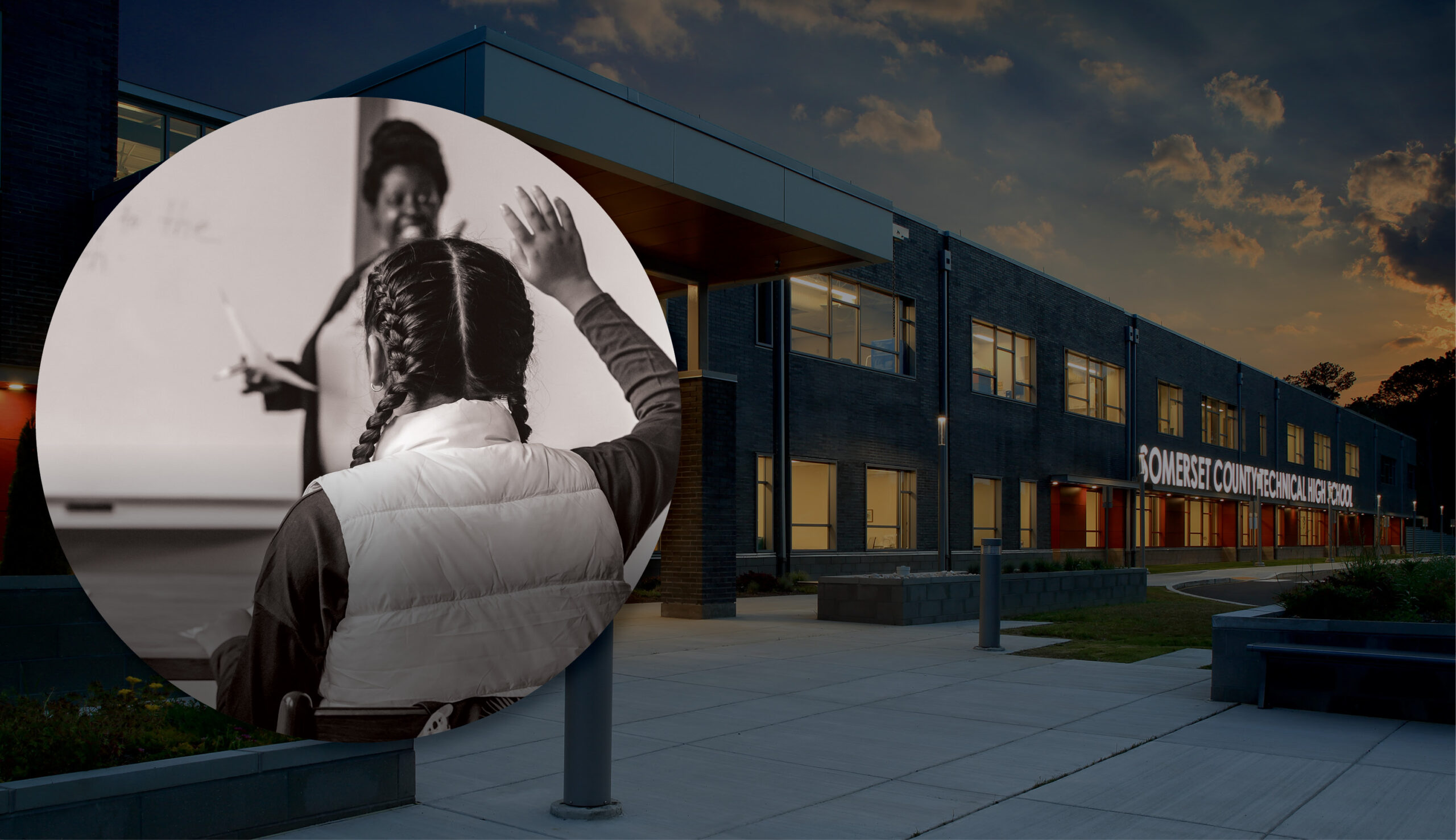Becker Morgan Group Melds State of the Art Design to District’s Vision and Budget

Somerset County, Maryland, is not the first place one might look for a world-class technical high school. Yet, nestled on the Eastern Shore far from any urban environment, situated in the state’s second poorest county, is Somerset County Technical High School (SCTHS), a $40 million award-winning state-of-the-art facility preparing students in this underserved area for careers and college.
SCTHS was designed by Becker Morgan Group, a firm known for its creative approach to educational spaces. Their innovative design for SCTHS takes advantage of every corner of the two-story, 103,000 square foot space, employing tools, materials, and professional services in new and even educational ways.
“This project was challenging from many angles, from scarcity of resources to the tight timetable,” said Brad A. Hastings, AIA, LEED AP, and Principal-in-Charge. “Yet, thanks to a highly cooperative team, enthusiastic school leadership and a strong dose of design ingenuity, we were able to deliver on time and under budget.”

Career Cluster Design Drives Collaboration
SCTHS is designed around the educational concept of ‘career clusters’ – areas of the school where traditional education overlaps with hands-on industrial training, and where the career paths themselves overlap for collaboration. For instance, where an HVAC class and an electrical engineering class can learn to work together as they might in real life.
Classrooms open into 33,000 square feet of adaptable laboratories housing an array of trades, such as HVAC, construction, welding, auto mechanics, culinary arts and many more.
“These are careers that are needed right now, today, in communities in our county and the surrounding area,” said Dr. John B. Gaddis, Superintendent of Somerset County Public Schools. “Our relationship with Becker Morgan Group allowed us to envision not only what we needed but what we wanted: a way for students to think differently about their futures.”
The district’s goal was clear: They wanted students in this economically depressed area to think higher and farther and to give them skills that allow them to go straight into viable, well-paying careers when they graduate, or go on to college or an advanced program with an education that allows them to support themselves and their dreams.
To achieve that, workshops and information sessions were held between the District, students, faculty, the community, and Becker Morgan Group to collect valuable feedback and input of the community’s needs. Hastings noted the importance of community input “It is crucial to not only keep the community informed but to include them in the design process. It is their tax dollars at work, and the facility will directly impact their futures; we’d be amiss if we didn’t value their opinions and insights. In Somerset’s case, the local business leaders pushed for a diesel program, something that wasn’t initially in the program, but ended up being added and will be of high value to the area.”

Designed for the Times
Balancing the lofty design goals were serious economic realities. The building had to be high quality and durable, yet budget was a very real concern. The Becker Morgan Group team sought creative solutions such as using a traditional steel-framed structure combined with a pre-engineered metal building for the high-bay lab areas.
“Our goal from the beginning was to do more with less. We made a decision early on to use the building itself as a teaching tool,” said Gaddis. “The design team was able to merge our desire to showcase how things in the building worked with real money-saving approaches that left us room to offer more career training options for students.”
To align with the goal of showcasing how the building works, the interior of the building features many exposed structural, mechanical, and electrical systems, such as HVAC, lighting and wiring for computers. Concrete floors, which are more budget friendly because they don’t require full finishes, were installed. The industrial design aesthetic is instructive and inspiring to students who see what they are learning in class employed in the very building in which they study, like a living lab. LED lighting and dramatic windows providing abundant natural light help save energy while invigorating the spaces.
This design strategy left room for other creative solves, such as a rooftop green space that is adjacent to the horticulture lab. It includes a teaching garden that makes use of a typically underutilized space, saves water runoff, and minimizes heat island effect, keeping the building cooler throughout hot summer months, while also providing an informal breakout or collaboration space for students and staff..
Another challenging aspect of the project was access to subcontractors. “Somerset County is in one of the more remote areas of the state,” said Sandra C. Carpenter, LEED AP BD+C, Project Manager. “Rather than being hampered by limitations, we turned the tables and solicited the local and regional workforce who wanted to make an impact on their community. There’s an immense sense of local pride built into this building.”
To save installation time and make the most of another design choice, the exterior is clad in thin brick. Offering the same benefits as full-bed masonry, the building system is lighter – which means the use of a less expensive steel frame – and can be installed more quickly. However, when approaching the building from any angle, it showcases what appears to be a traditional brick building as might be found on a college campus.

Open Doors to the Future
SCTHS opened in 2019 to accolades from students, faculty, and the community. The building itself was met with a host of certifications and awards, among them LEED Gold certification for its commitment to sustainable design, an AIA Maryland Merit Award for Institutional Architecture, and an ENR Mid-Atlantic award recognition for Best Project / Education K-12.
For all the awards, however, it is the students and community that were the winners. “Somerset County Technical High School (allows) students to enter the workforce with above-average wages in the immediate area and be better prepared for future opportunities. It gives them hope for a brighter future” noted Somerset County Director of Economic Development, Daniel Thompson.
